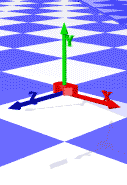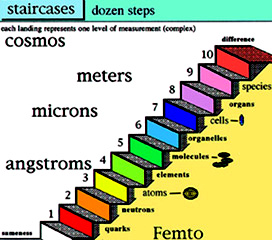 skepticism is a key to scientific inquiry
skepticism is a key to scientific inquiry Navigating
Richard P. Feynman, The Meaning of It All: Thoughts of a Citizen-Scientist. (1998)
The Uncertainty of Science,........................ pp. 3 - 28.
The Uncertainty of Values,............................ pp. 31 - 57.
The Unscientific Age,............. pp. 61 - 121.
Science simply defined is three related concepts.
Science is
- How we find things out,
- The body of knowledge of what we found out,
- What we do with what we discover (technology).
Richard Feynman, The Meaning of it All, p. 5.
Text | Definitions of science | Themes his inquiry | Writing about uncertainty | religion | problem | related ideas
Nature is . . . what it is.
"Its the way nature works . . . . its so shocking the way nature works."
There is measurable value in the ability to do something. So we should, or ought to know what we can accomplish, within observable limitations and without harm, for one another.
motive | humility | wonder | underlying quality | method | uncertainty
"But see that the imagination of nature is far, far greater than the imagination of man."
". . .such a marvel as nature is."
The Meaning of it All, pp. 6-7, 10.
Richard Feynman, author of Quantum Electrodynamics, was a physicist at Cal Tech for all his life after finishing his work on the Manhattan Project.
1965 Nobel prize winner in Physics for his work on
quantum electrodynamics about electrons & photons.
He served on the Commission investigating the causes of the Columbia space ship disaster in which all the astronauts on board perished on take-off. Feynman publicly rebuked the technicians for not understanding the basic impact of freezing or cold temperatures on the materials that make O-ring seals. The failure of these "O-ring" seals, a simple device brought down a complex machine causing the loss of human life. Feynman's disdain for the narrowly engineered view of materials and responsibility was palpable in his public demonstration where he immersed the O-ring seal in a cold glass of ice water. See Feynman speaking to the Commission.
The Meaning of it All is a posthumous publication of his three evening lectures as the John Danz lecturer at the University of Washington, in Seattle, during the spring of 1963.
Richard Feynman, The Meaning of it All, (1963).
"no matter what you look at, if you look at it closely enough, you are involved in the entire universe."
pp. 15-16.
Underlying similarity in materials, origins, and functions is one current finding of scientists.
"The world is a spinning ball, and people
are held on it on all sides, some of them upside down. And we turn like a spit in front of a great fire. We whirl around the sun. That is more romantic, more exciting. And what holds us? The force of gravitation, which is not only a thing of the earth but is the thing (force) that makes the earth round in the first place, holds the sun together and keeps us running (falling) around the sun in our perpetual attempt to (safely) stay away."
p. 10.
Earth and time are products of cosmic forces and neutron decay.
Deep time -- geological reconstruction from fossils, rock layers, pollen and tree rings reveals, a series of previous stages in existence where no humans, or even ancestral hominids, lived on earth.
There is evidence even for a "World without a living thing on it."
Life itself has a commonality found in:
Chlorophyll is composed of a six carbon loop, called a –porphyrin ring– that holds magnesium in a suspended state within a carbon nitrogen lattice. This is a similar structure responsible for respiration that holds either iron in hemoglobin, or copper in its place on a similar carbon-nitrogen lattice.
Chlorophyll is responsible for photosynthesis in bacteria & plants.
Proteins in bacteria & humans have the very same molecular structures that carry out respiration, by which each lives.
pp. 10-11.
"So close to life is life. The universality of the deep chemistry of living things is indeed a fantastic and beautiful thing. And all the same time we humans have been too proud even to recognize our kinship with the animals."
p. 12.
“Or there are the atoms. Beautiful – mile upon mile of one ball after another ball in some repeating pattern in a crystal. Things that look quiet and still, like a glass of water with a covered top that has been sitting for several days, are active all the time; the atoms are leaving the surface, bouncing around inside, and coming back. What looks still to our crude eyes is a wild and dynamic dance."
"And, again, it has been discovered that all the world is made of the same atoms, that the stars are of the same stuff as ourselves. It then becomes a question of where our stuff came from.... but where did the stuff of life and the earth come from?
It looks as if it was belched from some exploding star, much as some of the stars are exploding now. So this piece of dirt waits four and a half billion years and evolves and changes, and now a strange creature stands here with instruments and talks....”
"What a wonderful world."
p. 12.
despite the uncertainty, science has to be predictive
p. 25 .
Trying to understand the way nature works involves a most terrible test of human reasoning ability. It involves subtle trickery, beautiful tightropes of logic on which one has to walk in order not to make a mistake in predicting what will happen.
p. 15.
Uncertainty
“nothing can be stated precisely”
p. 25
“there is no harm in being uncertain.”
p. 26.
“All scientific knowledge is uncertain.”
“…It is of very great value , and one that extends beyond the sciences, I believe that to solve any problem that has never been solved before, you have to leave the door to the unknown ajar. You have to permit the possibility that you do not have it exactly right.”
pp. 26-27.
He argues that, “the rate at which you create new things to test,” is affected by the uncertainty that is recognized to persist despite our growing knowledge of material things.
p. 27.
“So what I call scientific knowledge today is a body of statements of varying degrees of certainty….none is absolutely certain.”
p. 27.
Text | Definitions of science | Themes his inquiry | Writing about uncertainty | religion | problem | related ideas
“How you get to know is what I want to know.”
p. 28.
“This freedom to doubt is an important matter in the sciences.”
“It was a struggle to be permitted to doubt, to be unsure.”
p. 28.
“…doubt is not to be feared, but that it is to be welcomed, as the possibility of a new potential for human beings.”
Doubt is clearly a value in the sciences.
p. 28.
Representation of three quarks (red, green and blue dots.) in a subatomic particle such as a proton or it ancestor neutron.
See: http://www.hrgbrg.com/2012/07/so-what-is-higgs-boson-anyway.html
What is the Higgs particle? The concept that completes the physical "understanding of how matter and the universe works." Gordon Watts, University of Washington. "The quantum of the Higgs field is the Higgs Boson particle."
The Uncertainty of Values, ...................................... pp. 31 - 57.
". . . men have been trying to fathom the meaning of life. . . . The dream is to find the open channel. What then is the meaning of it all?
. . .then I think we must frankly admit that we do not know. But I think by admitting this we have probably found an open channel.
"Admitting that we do not know and maintaining perpetually the attitude that we do not know the direction necessarily to go permit a possibility of alteration, of thinking, of new contributions and new discoveries for the problem of developing a way to do what we want ultimately, even when we do not know what we want."
"the worst of times,"
"times in which there were people who believed with absolute faith and absolute dogmatism in something."
p. 33.
Text | Definitions of science | Themes his inquiry | Writing about uncertainty | religion | problem | related ideas
"Well these scientific views end in awe and mystery, lost at the edge in uncertainty, but they appear to be so deep and so impressive that the theory that it is all arranged as a stage for God to watch man's struggle for good and evil seems inadequate."
p. 39.
A theme of an unfulfilled opportunity to thrive better
p. 31.
potential versus the reality of achievements
"falsehood and evil can be taught as easily as good"p. 31.
One can memorize and learn -- lies propaganda
"as well as real and valuable information"
a naiveté
not distracted by overload of information, media and infotainment in 1963?
"The applied science, for a while were thought to free men of material difficulties at lest, ..for example in medicine."31-32
There is a problem of duality here in that good or bad is not inherent in the practice or the body of knowledge that is science, or any subject.
Education
Communication and
applied sciences all are double edged swords for good or bad."We have more forces of this kind to control today than did the ancients."
"...compared to our confused accomplishments."
32
"don't seem to carry any clear instructions on how to use them."
"As an example, the great accumulation of understanding as to how the physical world behaves only convinces one that this behavior has a kind of meaninglessness about it. The sciences do not directly teach good and bad."
32
"We must frankly admit that we do not know."33
(Weltanschauung moment )33
"the worst times. . . . were times in which there were people who believed with absolute faith and absolute dogmatism in something."33
"I want to maintain here, that it is in the admission of uncertainty that there is hope for the continuous motion of human beings in some direction that doesn't get confined, permanently blocked, as it has so many times before....:
"we do not know what is the meaning of life"
34
"A belief in science and religion is consistent."
36
Text | Definitions of science | Themes his inquiry | Writing about uncertainty | religion | problem | related ideas
More on Feynman's Meaning
Cyanobacteria are aquatic and photosynthetic, that is, they live in the water, and can manufacture their own food. Because they are bacteria, they are quite small and usually unicellular, though they often grow in colonies large enough to see. They have the distinction of being the oldest known fossils, more than 3.5 billion years old, in fact! It may surprise you then to know that the cyanobacteria are still around; they are one of the largest and most important groups of bacteria on earth. If these creatures did not capture nitrogen and supply oxygen, life would be very different today.
Many Proterozoic oil deposits are attributed to the activity of cyanobacteria. They are also important providers of nitrogen fertilizer in the cultivation of rice and beans. The cyanobacteria have also been tremendously important in shaping the course of evolution and ecological change throughout earth's history. The oxygen atmosphere that we depend on was generated by numerous cyanobacteria during the Achaean and Proterozoic Eras. Before that time, the atmosphere had a very different chemistry, unsuitable for life as we know it today.
The other great contribution of the cyanobacteria is the origin of plants. The chloroplast with which plants make food for themselves is actually a Cyanobacteria living within the plant's cells. Sometime in the late Proterozoic, or in the early Cambrian, cyanobacteria began to take up residence within certain eukaryote cells, making food for the eukaryote host in return for a home. This event is known as endosymbiosis, and is also the origin of the eukaryotic mitochondrion.
Because they are photosynthetic and aquatic, cyanobacteria are often called "blue-green algae". This name is convenient for talking about organisms in the water that make their own food, but does not reflect any relationship between the cyanobacteria and other organisms called algae. Cyanobacteria are relatives of the bacteria, not eukaryotes, and it is only the chloroplast in eukaryotic algae to which the cyanobacteria are related.
Source:
University of California Museum of Paleontology
atoms
Bohr's idea
complexity
doubt
Energy formula
photons
radiation as energySee Steve's terrific science web site
Definitions of science | means of his inquiry | Writing about uncertainty | related ideas
Science Index | Social Analysis | Population Index | Global Warming Index | Nature Index | Genes | Brief

.gif)



